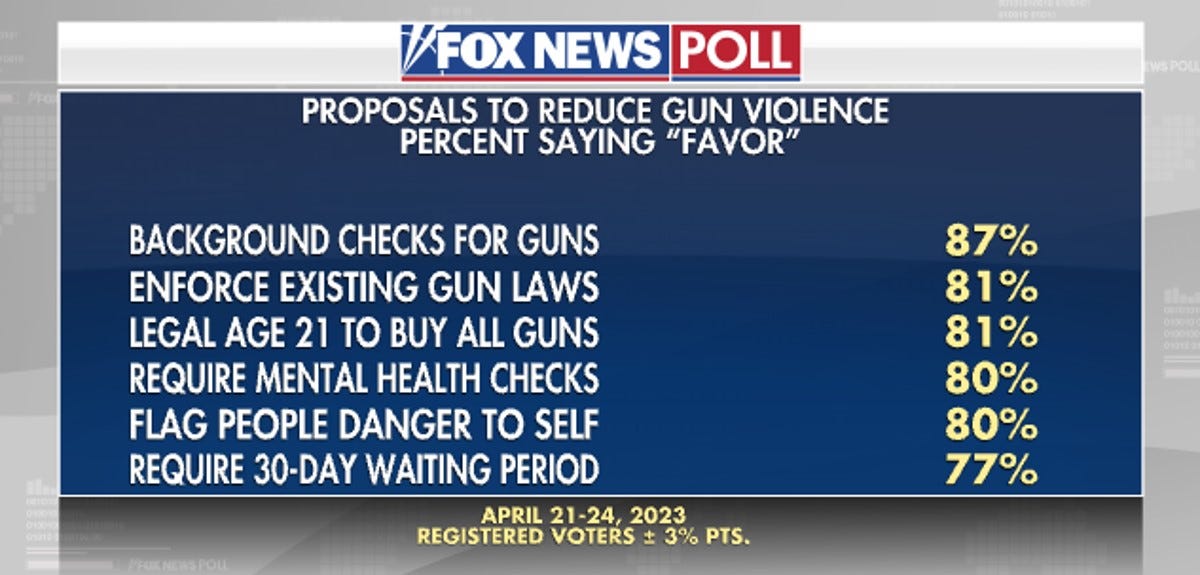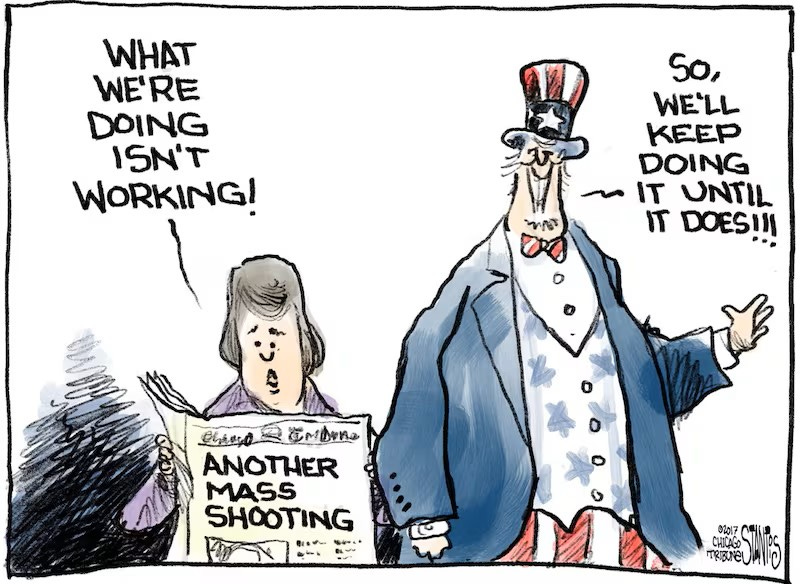Whether through criminal acts, by their own hand, or by accident—and often as a result of negligence—23 children are shot on average every day in the United States. In 2021, 2,571 children died in shootings, a 68% increase since 2000. The problem is so serious that firearms are now the leading cause of death among American children.
So what are the potential solutions to this crisis? One option is laws around safe storage, which are supported by 77% of American voters, across political affiliation. Eight states currently have such laws, but more are considering them. The Rhode Island Senate, for example, just approved a bill that would require all firearms to be stored in a locked container or equipped with a tamper-resistant mechanical lock when not being used by the owner or another authorized user.
But no law is foolproof. New York has a safe storage law, but it didn’t prevent an Albany 6-year-old from accidentally shooting his 3-year-old brother after finding an unsecured, loaded firearm in the house last month. To help encourage the safe storage of weapons, community outreach approaches are gaining traction. The U.S. Department of Education issued a resource for school administrators to use to educate school families on the importance of safe storage. Counseling about gun storage in the home is increasingly becoming routine in healthcare settings as well.
Then there’s technology. A Colorado-based startup just released a new ‘smart gun’ that aims to prevent kids from shooting their parents’ weapons. The smart gun is equipped with fingerprint and facial-recognition technology that allows it to fire only when held by authorized users. There are also gun holsters on the market that work in a similar fashion.
Finally, there’s good old-fashioned parental responsibility. Following the Jennifer and James Crumbley case, will more parents be held criminally responsible if their kids commit violent acts with a firearm? Possibly. Virginia Gov. Glenn Youngkin just vetoed a host of gun-related bills, but he did sign into law a measure that would allow for parents to be charged with a felony if they allow a child to have access to a firearm after being notified the child poses a threat of violence.
There are pros and cons to all of these solutions. Let us know what you think of them in the comments.
On the Hill
The U.S. Department of Justice has teamed up with Johns Hopkins University to launch a national resource center to help states implement their red flag laws, formally known as Extreme Risk Protection Orders (ERPOs). Red flag laws, which keep guns out of the hands of people who pose a threat, have been shown to be effective at preventing suicides and mass shootings, as well as reducing incidents of domestic violence. However, some of the 21 states with red flag laws have faced problems with enforcement due to a lack of coordination, training, or support. The National Extreme Risk Protection Order Resource Center “will provide training and technical assistance to law enforcement officials, prosecutors, attorneys, judges, clinicians, victim service and social service providers, community organizations, and behavioral health professionals.”
We say: We applaud this initiative, as our research has shown that gun owners are largely receptive to red flag laws as long as timely due process is prioritized.
More on the Hill:
DC police dealt thousands of guns; ATF demands answers after concerning number found at crime scenes —NBC4 Washington
In the Courts
The NRA has hit a rough patch lately, to put it mildly, so a recent decision by a Democratic-appointed judge was a big win for its 4 million members. Last year, the embattled organization filed a lawsuit against the Bureau of Alcohol, Tobacco, Firearms and Explosives (ATF), arguing that a measure introduced by the agency to reclassify pistols equipped with braces as short-barreled rifles is unconstitutional. U.S. District Judge Sam Lindsay agreed, ruling that NRA members do not have to comply with the ATF order to register, modify, or destroy their firearms.
More in the courts:
Federal court rules firearm restrictions on defendants awaiting trial are constitutional —Maryland Daily Record
Judge: Unlawful Migrants Have Right to Bear Arms —The Dallas Express
‘Ghost gun’ dealer shuts down following settlement with Connecticut —WFSB
Attorney General Taylor joins coalition to oppose Illinois ban on AR-15 rifles, 30-round magazines —Must Read Alaska
Chicago sues gunmaker Glock over firearm conversions to machine guns —Scripps News
Appeals court skeptical of challenge to Maryland assault weapons ban —Reuters
Supreme Court Asked to Halt Morality Requirement in New York Gun Law —Bloomberg Law
Ohio Supreme Court to hear case on Columbus gun laws —NBC News
Pennsylvania Court Upholds Right of Young People to Carry Guns in Public —NTD
In the States
Since our last issue, governors in two states vetoed—and signed—gun legislation. In Wyoming, Gov. Mark Gordon vetoed legislation that would have eliminated gun-free zones in favor of allowing schools and local governments to retain control over who can or can’t carry concealed weapons onto their premises. He also signed four Second Amendment-friendly bills, including one that protects the privacy of gun owners by prohibiting credit card processors from using firearms or firearm-related merchant category codes. Virginia Gov. Glenn Youngkin vetoed a number of gun-related bills, most notably one that would ban semi-automatic weapons in the state. But he signed two pairs, including one that bans auto sears, which convert semi-automatic handguns into automatic weapons.
We say: Though we disagree with some of their choices (in particular, Wyoming’s prohibition of red flag laws), we commend Govs. Gordon and Youngkin for thoughtfully balancing public safety with the protection of Second Amendment rights.
More in the states:
Fearing political violence, more states ban firearms at polling places —Pennsylvania Capital-Star
Colorado: Facing skepticism, Democrats eliminate dozens of 'sensitive spaces' from gun control bill —CPR News
Georgia: Savannah considering penalties for those who leave guns unsecured in vehicles —Savannah Now
Illinois: Legislation would require third background check, mandatory training for gun purchases —The Highland County Press
Maine: Democrats advance governor’s bill on gun violence —Spectrum Local News
Maine: Red flag bill heads to public hearing —WGME
Massachusetts: Lawmakers seek to finalize gun control bill —The Eagle Tribune
Michigan: Police are using red flag law to seize guns from people deemed to be a threat —Bridge Michigan
Minnesota: Another round of gun law changes again in the mix at the Capitol —MPR News
New Hampshire: Republicans split, pass bill adding mental health records to gun checks —New Hampshire Bulletin
New Mexico: Gun laws could increase concealed carry permits —Albuquerque Journal
New York: NYC will test AI gun detectors on the subway —The Verge
North Carolina: Focus during short session on tightening gun laws —Charlotte Observer
Pennsylvania: Constitutional questions remain after House passes ‘self-assembled firearms’ parts ban —Tri-State Alert
Tennessee: Lawmakers advance bill allowing teachers to carry firearms, rejects bills restricting gun access —WPLN News
Tennessee: Bill to ban assault weapons dismissed without discussion —Local 3 News
What is the difference between Constitutional carry and concealed carry?
The governors of Louisiana and South Carolina signed Constitutional carry measures last month, becoming the 28th and 29th states to do so. How does it differ from concealed carry? Also known as permitless carry, Constitutional carry is the ability to carry a concealed firearm without paying a fee or acquiring a permit from your resident state. It streamlines the process of carrying a firearm and lets people exercise their Second Amendment rights without government interference.
Concealed carry is the ability to carry a concealed firearm with a state-issued permit or license. Concealed carry permits usually involve taking a training course, passing a written test, paying a fee, and submitting an application to the state. Depending on the state, applicants may also be subject to background checks, fingerprinting, and other criteria. The main benefit is that it offers more flexibility for gun owners who want to travel with their firearms. (Sources: U.S. Concealed Carry Association, Cedar Mill Firearms)
“I’m a gun owner and a strong Second Amendment supporter. I’m also a physician and a grandfather. We have reached a public-health crisis where firearms are now the No. 1 killer of kids in America. Shockingly, the rate of firearm fatalities among children under 18 increased 87 percent from 2011 to 2021. Had the problem been this large during my time in the U.S. Senate…it would have unquestionably influenced my vote on key firearm-related legislation. I want to see proven firearm-safety policies enacted that protect our children—which we can achieve while preserving our Second Amendment rights.” —Former U.S. Senator Bill Frist of Tennessee
“The false dichotomy that has long polarized the gun debate does not serve us. While some of us deal with our problems in the mountains and others in the city, we all want to find solutions to our toughest problems. This is only possible when we have the courage to step outside of our partisan camps to find higher ground together.” —Jay Zimmerman, a combat veteran who works in mental health and suicide prevention, and Alyssa Pearman, an educator and youth advocate. Both were part of the ‘Tennessee 11.’
Do you have a comment about any of these critical issues? Do you have a story to share? We’d love to hear from you. Please include your first name and state, and we may publish it in a future issue. Thank you for reading!
For more information about 97Percent, please visit our website at 97Percent.us.
Join our growing community of gun owners and non-gun owners united to reduce gun deaths in America.











"We have reached a public-health crisis where firearms are now the No. 1 killer of kids in America." — Former U.S. Senator Bill Frist of Tennessee
^ Why are you perpetuating a claim that has been debunked, once you acknowledge that 18-19 year-olds are adults?
"The claim that guns were the leading cause of death for U.S. children in 2020 and 2021 is true only if the selected age range is 1-19 years old. This range excludes infants under one year old, who have a unique risk of age-specific causes of death.
Similarly, capping the age range at 17, instead of 18 or 19, also alters the result, as children aged 17 and under have a greater risk of dying of vehicle-related injuries."
https://www.snopes.com/news/2023/03/29/guns-leading-deaths-children-us/
Why do you like your own posts? We know you like it, you wrote it.
It comes across as shady.